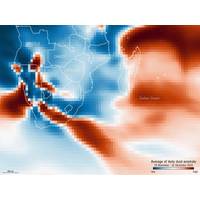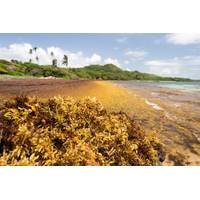
An Arctic “Beyond Recognition” Expected by 2100
In 2024, annual average global air temperatures surpassed 1.5 degrees Celsius above pre-industrial levels for the first time, triggering extreme weather events like record-breaking rainfall and flooding events in the Sahara Desert and extreme summer heat waves across the planet.Based on the current pledges of countries for limiting their emissions of greenhouse gases, global temperatures are projected to reach 2.7 degrees Celsius beyond pre-industrial levels by the end of this century.A new review paper, published in Science on February 6, 2025, highlights the expected changes to the Arctic, the

South African Drought Dust Fueled Record Ocean Bloom
ocean absorbs from the atmosphere."The study used satellite data to study the causes of major phytoplankton blooms, focusing on the unprecedented Madagascar Bloom in late 2019 to early 2020, which was found to be the largest on record going back 24 years.It’s already known that dust from the Sahara Desert often crosses the Atlantic Ocean to the Americas and that when these particles settle on land or in the ocean, they deliver essential nutrients that may boost plant and marine life growth.However, the relationship between desertification, dust emissions and ocean fertilisation has been poorly

Massive Bloom of Brown Seaweed Heads Toward Florida and the Caribbean
and soybean farming in the Amazon basin are sending rising levels of nitrogen and phosphorus into the Atlantic Ocean via the Amazon and Orinoco rivers. These nutrients are key ingredients in fertilizer, and also are present in animal manure.Another major source of nutrients is dust clouds from the Sahara, which can stretch for thousands of miles across the Atlantic Ocean, carried by trade winds. These clouds contain iron, nitrogen and phosphorus from dust storms in Saharan Africa and biomass burning in central and southern Africa. As they blow across the Atlantic, they help fertilize seaweed.A threat

Scientists Come Closer to Solving Caribbean Seaweed Mystery
is not yet definitive. This nutrient-charged outflow is just one of several likely culprits fueling an explosion of seaweed in warm waters of the Americas. Six scientists told Reuters they suspect a complex mix of climate change, Amazon rainforest destruction and dust blowing west from Africa’s Sahara Desert may be fueling mega-blooms of the dark-brown seaweed known as sargassum.In June 2018, scientists recorded 20 million metric tons of seaweed, a 1,000% increase compared with the 2011 bloom for that month.“There are probably multiple factors” driving the growth, said oceanographer
Kosmos Energy's Update
Kosmos Energy announced today that the CB-1 exploration well located in the Cap Boujdour permit area offshore Western Sahara encountered hydrocarbons. The well penetrated approximately 14 meters of net gas and condensate pay in clastic reservoirs over a gross hydrocarbon bearing interval of approximately 500 meters. The discovery is non-commercial, and the well will be plugged and abandoned. Andrew G. Inglis, chairman and chief executive officer, said: “The CB-1 exploration well was designed to open the frontier Laâyoune Basin by testing the Al Khayr Prospect. While not a


 February 2025
February 2025





